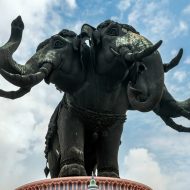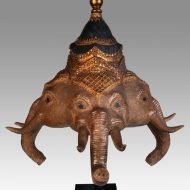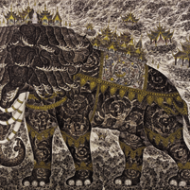Erawan : The Mighty Elephant
Listen
At a glance
| Description | |
|---|---|
| Origin | Thai Mythology |
| Classification | Animals |
| Family Members | Iravati (Mother) |
| Region | Thailand, India |
| Associated With | War, East |
Erawan
Introduction
In the rich fabric of Thai mythology, Erawan emerges as a captivating figure, embodying both awe-inspiring power and divine grace. Known as Airavata in Hindu lore, this mythical being serves as the steadfast mount of Indra, the king of the gods, symbolizing strength, wisdom, and prosperity. With its imposing form adorned with up to thirty-three heads and multiple tusks, Erawan stands as a potent symbol of Bangkok’s ascendance as the capital of the Kingdom of Thailand, a testament to its deep-rooted connection to cosmic order and ancestral lineage.
Across the mythological landscape, Erawan’s name echoes with reverence and mystique, evoking images of celestial majesty and benevolence. Associated with auspicious events and celestial protection, it embodies the enduring legacy of Thai folklore, where gods and mortals intertwine in a dance of destiny. Depicted in statues alongside Indra, the king of Tatimata Heaven, Erawan symbolizes the divine bond between earthly realms and the celestial sphere, bridging the gap between mortal aspirations and transcendent truths.
Beyond the borders of Thailand, Erawan’s influence resonates across Southeast Asia, where it is revered as a symbol of sovereignty and strength. From the former Kingdom of Laos to the royal courts of Lan Xang, the three-headed elephant adorns flags and monuments, serving as a beacon of divine protection and national identity. In this way, Erawan transcends the confines of myth and legend, weaving its majestic presence into the very fabric of cultural heritage and spiritual consciousness across the region.
Physical Traits
Erawan, depicted as a majestic elephant with an imposing presence, is a manifestation of cosmic significance deeply rooted in Thai mythology. Adorned with intricate details reflective of Thai artistic tradition, each of Erawan’s heads embodies a distinct aspect of existence, from serenity to fierceness. With its graceful tusks hinting at regal lineage, Erawan exudes an aura of power and wisdom, captivating all who behold its magnificence.
In various renditions, Erawan’s colossal stature is emphasized, often depicted with an astounding thirty-three heads, each adorned with seven tusks. This imagery underscores Erawan’s cosmic significance, with each head symbolizing a unique facet of the universe. Despite such grand depictions, more commonly portrayed are Erawan’s three heads, each representing wisdom, power, and protection. Legends further embellish Erawan’s magnificence, attributing to it the weight of the entire world upon its back.
Throughout Thai folklore, Erawan’s mythos evolves, intertwining with tales of gods and celestial realms. As the steed of Indra, the god of war and thunder, Erawan symbolizes divine authority and celestial guardianship. Its thirty-three heads, each adorned with seven tusks, are said to preside over intricate celestial realms, populated by dancing angels and their accompanying ladies-in-waiting. Such imagery amplifies Erawan’s divine stature, solidifying its place as a revered figure in the pantheon of Thai mythology.
Family
According to various mythological texts, including the Ramayana and the Matangalila, Erawan’s lineage is steeped in ancient tales of creation and divine birth. In the Ramayana, Iravati is mentioned as the mother of Airavata, Erawan’s counterpart in Hindu mythology. Meanwhile, the Matangalila recounts a tale where Brahma’s sacred songs, sung over hatching eggshell halves, give rise to Erawan along with other elephants and the mythical creature Garuda.
Erawan’s family ties are further intertwined with the celestial realms through its connection to Indra in Hindu mythology. Indra, regarded as a divine ruler, is the offspring of Kashyapa, a primordial sage, and Aditi, a personification of cosmic order. Despite the ambiguity surrounding Erawan’s precise origins, Thai mythology associates it with Phya Khankhaak, the mythical elephant supporting the world. This lineage not only portrays Erawan as a guardian figure with deep ancestral roots but also emphasizes its significance in upholding cosmic order within the pantheon of Thai deities.
Other Names
The Hindu mythical being, known as Airavata, holds various names across cultures. In Sanskrit, it is referred to as Airawana, while in Thai, it is known as Airapot, Airawat, or Erawan. These names are evocative of the phenomena associated with rain clouds and lightning, symbolizing the presence of the god Indra riding atop the elephant known as Erawan. This celestial elephant’s name resonates throughout Southeast Asia, with variations like Eravana in Khmer mythology. Despite these diverse appellations, they all converge to signify the same divine essence, embodying strength, resilience, and spiritual insight.
Powers and Abilities
Erawan’s primary duty revolves around serving as the mount of Indra, accompanying the god as he traverses the realms of Earth and heavens to observe the fortunes of mankind. Associated with the east, Erawan assumes the role of Indra’s war elephant during battles against demons, symbolizing strength and resilience in the face of adversity. As the chief deity of the gods, Indra wields the lightning bolt to combat drought and bestow beneficial rains upon the world. In this divine partnership, Erawan acts as a conduit, facilitating the transfer of moisture from the sky to the earth, embodying the life-giving force of rainfall.
Erawan’s association with Indra bestows upon him immense power and significance. Revered as the lord of all elephants, Erawan embodies the majestic qualities inherent in these creatures, revered for their strength and wisdom. The multiple heads adorning Erawan’s form symbolize his ability to perceive multiple realities simultaneously, serving as a source of wisdom and guidance for those who venerate him. Throughout South and Southeast Asia, Erawan is revered as a benevolent deity, revered for his association with rainfall and his role in sustaining life on Earth.
Modern Day Influence
In modern times, Erawan has risen to prominence as one of Thailand’s most cherished cultural symbols, epitomized by the grand statue erected at the entrance of the Erawan Museum in Bangkok. This monumental structure beckons visitors, inviting them to embark on a journey inside the hollowed statue of the mythical Erawan, an essential experience for any traveler exploring Thailand. The tale surrounding Erawan’s significance intertwines with folklore, including the story of an old hermit’s curse upon the angels surrounding the realm, a consequence of Erawan’s dislike of pollen and his inadvertent injury to the mighty Indra.
Despite its ancient origins, Erawan’s influence persists in contemporary Thai culture, permeating various facets of society. Its presence is palpable in religious ceremonies, artistic endeavors, and public spaces, serving as a powerful emblem of national identity and spiritual heritage. Travelers encounter Erawan’s likeness in temples and shrines, where it stands as a testament to Thailand’s rich mythological tapestry and enduring cultural legacy.
Furthermore, Erawan’s resonance extends beyond Thailand’s borders, manifesting in literature, film, and art that capture its mythical allure. Through these mediums, Erawan’s story transcends temporal and spatial boundaries, captivating audiences worldwide and fostering a deeper appreciation for Thai folklore. In this way, Erawan transcends the limitations of time and space, serving as a bridge between ancient wisdom and contemporary sensibilities, enriching both Thai culture and the global imagination.
Related Images
Frequently Asked Questions
What does Erawan mean?
Erawan, the mighty Thai elephant, lacks a direct meaning. However, linked to Airavata, its essence might evoke water, clouds, and rainbows, reflecting its connection to the rain-bringing Indra.
Who is Erawan in Hinduism?
In Hinduism, Erawan doesn’t actually exist as a separate deity. Erawan is the Thai name for Airavata, the magnificent white elephant who serves as the mount of Indra, the king of the gods.
What is Erawan in Thailand?
Thailand’s Erawan isn’t a god, but a revered form of Airavata, Indra’s (king of gods) mighty white elephant. He embodies strength, wisdom, and prosperity. His image graces art, regalia, and even parks. Offerings flow to him despite shrines honoring Brahma. Erawan reflects Thai culture’s deep connection to myth and nature.
What is the myth of Erawan?
Erawan lacks his own myth, but borrows from Airavata’s tale. Emerging from the cosmic churn (maybe a gift from Shiva), he became Indra’s mount, a symbol of strength. His multiple heads reflect cosmic awareness, and his link to Indra hints at bringing rain. Erawan’s story, though borrowed, showcases power, wisdom, and cosmic importance.
Who rides Erawan?







